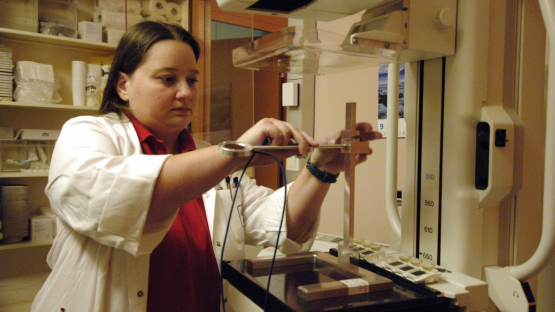The IAEA has launched a five-year Coordinated Research Project (CRP) to improve the accuracy of dosimetry in diagnostic and interventional radiology. The new CRP starting this year seeks to provide data needed for the update of the IAEA Technical Reports Series (TRS) No. 457 “Dosimetry in Diagnostic Radiology: An International Code of Practice”.
International standardization in dosimetry is essential for the safe and effective optimization of radiation technology in the clinical environment. This is particularly true for medical diagnostic procedures in radiology that contribute to an ever increasing proportion of the total population dose from human-made sources of ionizing radiation. Different irradiation conditions in terms of incident X ray beam quality and geometry have led to the definition of application-specific dosimetric quantities and methods, as described in the IAEA TRS No. 457 published in 2007.
In line with the IAEA’s role to provide guidance in dosimetry, a need was identified to explore new X ray technologies and detectors used in the clinical environment for the update of the IAEA TRS-457 which would also include the perspectives of both the standards dosimetry laboratories and clinical radiology medical physics environment.
Six to eight contract holders will be selected to participate in this CRP. Applications for research agreements will also be considered. Each team will bring expertise from dosimetry laboratories and/or clinical medical physicists working in the field of diagnostic and interventional radiology. This CRP builds upon the previous CRP titled Testing of Various Procedures Described in the IAEA TRS-457 (E2.10.06), which ran from 2005 to 2008.
CRP objective
The main objective of the CRP is to standardise radiology medical physics dosimetry instrumentation, equipment and procedures in laboratories and hospitals, and support the update of the IAEA TRS No. 457.
The specific research objectives are:
- To provide recommendations on the performance specifications for reference dosimeters in laboratory and clinical environments for different beam qualities (standard radiation beam qualities (RQR), radiation qualities for computed tomography (CT) applications (RQT) and radiation qualities for mammography applications (RQM)).
- To assess the accuracy of measurements, e.g. practical peak voltage (kVp), kerma, kerma rate, total filtration, half value layer (HVL), etc. performed using semiconductor-based dosimeters (in standard radiation qualities (RQR), mammography applications (RQM), CT applications (RQT)).
- Develop and test harmonized methodologies for kerma-area product (PKA) measurements relevant to calibration laboratories and end users at the hospitals in cone beam computed tomography (CBCT), dental radiology and interventional procedures.
- To obtain data pertaining to intra- and inter-scanner variations in measured vs. displayed CT dose indices.
Funding
To support some expenses of the project each awarded Research Contract will have an annual financial support for a period of 4 years (subject to annual review). All participants of the CRP are required to attend three Research Coordination Meetings at the IAEA’s expense. During the application process teams will be expected to provide a detailed budget outline.
How to participate in the CRP
The expected duration of the CRP is 5 years (2021—2025). The CRP is open to all Member States with one or more of the following expertise:
- Experienced radiation metrologists from the IAEA/WHO Secondary Standards Dosimetry Laboratory (SSDL) Network members providing services in the diagnostic radiology field.
- Clinically qualified medical physicists from public hospitals providing comprehensive diagnostic and interventional radiology services.
- Scientists from Primary Standards Dosimetry Laboratories (PSDLs) providing services in the diagnostic radiology field.
Additional requirements for participating dosimetry laboratories are:
-
- Established procedures for calibrations and comparisons in the field of diagnostic radiology;
- Collaborations with hospitals that provide comprehensive diagnostic and interventional radiology services.
Additional requirements for participating hospitals are:
-
- Access to a range of imaging equipment that is subject to a comprehensive quality assurance programme;
- Several different types of detectors and calibrated systems for performing diagnostic radiology quality control and dosimetry.
Interested institutions should submit their Proposal for Research Contract or Agreement by email, no later than 31 May 2021, to the IAEA’s Research Contracts Administration Section, using the appropriate template on the CRA website. The first Research Coordination Meeting is planned for 22—26 November 2021.
For further information related to this CRP, potential applicants should use the contact form under the CRP page.




